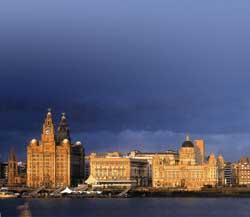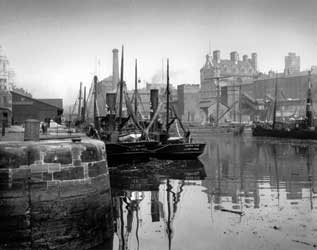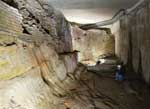

In 1700, Liverpool was a small town with a dock that was in danger of silting up. Yet it was a town with prospects: Chester, which had hitherto been the main port in the north-west, was silting up even more. The discovery of the Americas had increased the importance of ports facing the Atlantic, and the citizens of Liverpool decided to capitalise on the situation by building an innovative ‘wet dock’. The dock had massive gates that were opened only at high tide, and so kept the level of water at high-tide level within the dock, which meant that ships could unload straight on to the dockside while still afloat.
The Old Dock proved to be an enormous success, as it meant that ships could be loaded in one and a half days, instead of the 12 to 14 days that had been needed previously. Liverpool grew rapidly and soon overtook Bristol to become the second largest port in the country after London. The position of the port meant that Liverpool was also convenient for the West African trade, forming the apex of the trading triangle between Africa and the West Indies, and by 1792, the port possessed over half of the English cotton and slave trade. However when the Slave Trade Act of 1807 abolished the slave trade, Liverpool expanded even more, as it became an important port for cotton, located as it was close to the cotton and textile mills of Lancashire.
By the end of the 19th century, a massive 9% of all world trade went through Liverpool Docks, but by this time the Old Dock was long gone; it had been superseded by many bigger and deeper docks, constructed out into the Mersey. The Old Dock, the world’s first commercial enclosed wet dock, was backfilled in 1826.
 The Paradise project (now known as Liverpool 1), was undertaken as a massive rebuilding of 43 acres of the city centre to redouble the retail area and revivify the dock front. It was in the course of this activity that the Old Dock was rediscovered. This huge project has now changed the entire character of the city centre. But will the Old Dock be preserved? Because of the recognised archaeological importance of the dock, almost all of it has been preserved within the development’s design. This has entailed considerable further excavation (undertaken by Oxford Archaeology North between 2001 and 2008) to determine the lines of the wall, and the north-eastern corner of the dock has been preserved within a large secant pile-enclosed box (see picture left). Will this eventually become the Old Dock Information Centre?
The Paradise project (now known as Liverpool 1), was undertaken as a massive rebuilding of 43 acres of the city centre to redouble the retail area and revivify the dock front. It was in the course of this activity that the Old Dock was rediscovered. This huge project has now changed the entire character of the city centre. But will the Old Dock be preserved? Because of the recognised archaeological importance of the dock, almost all of it has been preserved within the development’s design. This has entailed considerable further excavation (undertaken by Oxford Archaeology North between 2001 and 2008) to determine the lines of the wall, and the north-eastern corner of the dock has been preserved within a large secant pile-enclosed box (see picture left). Will this eventually become the Old Dock Information Centre?
For the full article, see CA 233



